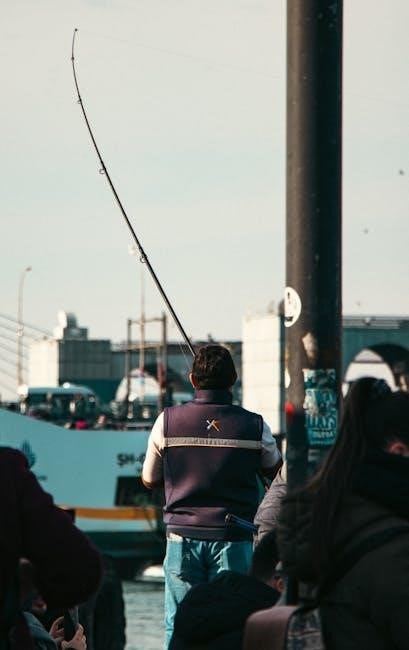Fishing pole guides are essential components, directing line flow and preventing tangles; understanding types and proper selection enhances casting and overall fishing experiences.
Selecting the correct rod is crucial for matching your preferred fishing style, ensuring optimal performance and enjoyment on the water.
Mastering fishing skills, like gathering, crafting potions, and cooking food, requires understanding essential techniques and equipment, including quality guides.
What are Fishing Pole Guides?
Fishing pole guides are the small rings strategically positioned along a fishing rod’s blank. They serve a critical function: to manage the fishing line as it travels from the reel to the lure or bait. These guides aren’t merely placeholders; they actively control the line, preventing it from directly contacting the rod itself.
Historically, wire guides, including traditional double-footed “snake guides” and single-foot styles, were commonplace. Modern rods increasingly utilize materials like ceramic, aluminum oxide, silicon carbide (SiC), and zirconium oxide for smoother line travel and reduced friction. The construction and placement of these guides significantly impact casting distance, accuracy, and overall fishing performance.
Essentially, they are the pathway for your line, ensuring a smooth, controlled delivery with every cast.
Why are Guides Important?
Fishing pole guides are paramount for several reasons, directly impacting the fishing experience. Primarily, they prevent the fishing line from rubbing directly against the rod’s blank, which would cause significant friction and potential damage to both line and rod. This friction reduces casting distance and can weaken the line, leading to breakages during a fight with a fish.
Properly functioning guides also ensure smooth line flow, enhancing casting accuracy. Different guide types and materials minimize friction, allowing for longer, more effortless casts. Furthermore, guides distribute stress along the rod blank, contributing to its overall durability and preventing localized weak points. Ultimately, quality guides translate to improved performance and a more enjoyable day on the water.

Types of Fishing Pole Guides
Fishing pole guides come in diverse forms, including wire guides (snake and single foot), ceramic, aluminum oxide, silicon carbide (SiC), and zirconium oxide options.
Wire Guides: Snake Guides
Snake guides represent a traditional and widely utilized style of wire guide, characterized by their distinctive double-foot design. This construction provides enhanced stability and durability, making them a reliable choice for various fishing applications. They are commonly found along the length of a fishing rod, strategically positioned to smoothly guide the fishing line from the reel to the rod tip.
The double-foot structure of snake guides offers superior support, minimizing wobble and ensuring consistent line control during casting and retrieval. These guides are particularly effective in distributing stress, reducing the risk of breakage under pressure. Available in various materials like stainless steel and chrome-plated options, snake guides remain a popular selection for both novice and experienced anglers.
Wire Guides: Single Foot Guides
Single foot guides offer a streamlined alternative to traditional snake guides, distinguished by their simpler design featuring only one mounting foot. This lighter construction contributes to a reduction in overall rod weight, enhancing sensitivity and casting performance. They are often strategically incorporated into rod builds, particularly in areas where minimal weight is desired, such as near the rod tip.
While offering weight advantages, single foot guides may require careful placement and secure wrapping to maintain stability. They are frequently used in conjunction with snake guides, creating a hybrid system that balances weight reduction with robust support. Available in various finishes, including chrome and stainless steel, single foot guides provide anglers with a versatile option for customizing their rod’s performance.
Ceramic Guides
Ceramic guides represent a significant advancement in fishing rod technology, prized for their exceptional durability and ability to minimize friction. These guides feature a ceramic ring – often aluminum oxide, silicon carbide (SiC), or zirconium oxide – bonded to a metal frame. The smooth ceramic surface drastically reduces line wear, extending line life and improving casting distance.
Ceramic guides are particularly effective when used with braided fishing lines, which are known for their higher friction coefficient. They dissipate heat generated during long casts, preventing line damage. While generally more expensive than traditional metal guides, the enhanced performance and longevity of ceramic guides make them a popular choice among serious anglers.
Aluminum Oxide Guides
Aluminum oxide guides are a widely used and cost-effective option in fishing rod construction, offering a balance between performance and affordability. These guides utilize an aluminum oxide ceramic ring, known for its reasonable durability and resistance to wear. They provide a smoother surface than traditional metal guides, reducing friction on the fishing line and improving casting distance.
While not as hard or heat-resistant as silicon carbide or zirconium oxide, aluminum oxide guides are suitable for a broad range of fishing applications, particularly with monofilament and fluorocarbon lines. They represent a solid upgrade from basic metal guides, delivering improved performance without a significant price increase.
Silicon Carbide (SiC) Guides
Silicon Carbide (SiC) guides represent a significant step up in performance, prized for their exceptional hardness and smoothness. These guides minimize friction on the fishing line, resulting in longer, more accurate casts and reduced line wear. The incredibly hard surface resists abrasion from braided lines, a common issue with softer materials.
SiC guides also dissipate heat effectively, crucial when using high-speed reels and fighting larger fish. While more expensive than aluminum oxide, the enhanced performance and durability make them a popular choice for serious anglers. They are a premium option, offering a noticeable improvement in casting and overall fishing experience.
Zirconium Oxide Guides
Zirconium Oxide guides are positioned as a high-performance alternative to traditional aluminum oxide and even Silicon Carbide in certain applications. They offer excellent hardness and durability, providing smooth line flow and reducing friction during casting. This translates to increased casting distance and reduced line wear, particularly beneficial with modern braided lines.
Zirconium Oxide boasts impressive resistance to cracking and chipping, ensuring a longer lifespan compared to some other guide materials. While often slightly less expensive than SiC, they deliver comparable performance for many anglers. They represent a sweet spot between cost and quality, making them a favored choice for a wide range of fishing styles.

Materials Used in Guide Construction
Guide frames commonly utilize stainless steel, chrome plating, or titanium, offering varying levels of corrosion resistance and strength for long-lasting performance.
Wire guides, available in double or single foot styles, are constructed from durable materials to withstand repeated use and line tension.
Stainless Steel Frames
Stainless steel remains a popular choice for fishing pole guide frames due to its balance of affordability, durability, and corrosion resistance. While not as lightweight or corrosion-proof as titanium or certain ceramic options, stainless steel provides reliable performance in both freshwater and saltwater environments.
These frames are typically used in conjunction with various guide inserts, such as ceramic or aluminum oxide, to create a smooth line-passing surface. The steel itself is often treated or coated to further enhance its resistance to rust and wear.
Stainless steel frames are a cost-effective solution for many anglers, particularly those who fish recreationally or in less demanding conditions. They offer a good level of strength and longevity without the higher price tag associated with premium materials.
Chrome Plated Frames
Chrome plated frames, once a common sight on fishing rods, offer a visually appealing, shiny finish. However, their popularity has decreased as anglers have recognized limitations in long-term durability and corrosion resistance compared to stainless steel or titanium.

The chrome plating itself is relatively thin and susceptible to chipping, scratching, and corrosion, especially in saltwater environments. Once the chrome layer is compromised, the underlying metal is exposed, leading to rust and potential weakening of the guide frame.
While chrome plated frames are generally more affordable than stainless steel, their reduced lifespan and susceptibility to damage often make them a less practical choice for serious anglers. They are now primarily found on lower-priced rods.
Titanium Frames
Titanium frames represent a premium option in fishing pole guide construction, prized for their exceptional strength-to-weight ratio and unparalleled corrosion resistance. This makes them ideal for both freshwater and, crucially, saltwater applications where rust is a significant concern.

Titanium is incredibly durable, resisting bending and warping even under considerable stress. While more expensive than stainless steel or chrome, the longevity and performance benefits often justify the investment for dedicated anglers.
The lightweight nature of titanium also contributes to a more sensitive rod, enhancing feel and bite detection. They are often paired with high-quality ceramic inserts for optimal line flow and reduced friction.
Guide Placement and Configuration
Guide placement is critical for optimal casting distance and accuracy; proper alignment with the rod’s spine minimizes friction and maximizes line control during retrieves.
First Guide Placement
The first guide’s position is arguably the most crucial aspect of guide configuration on a fishing rod. It significantly impacts casting performance and line control. Generally, the first guide should be positioned approximately 20-30 inches from the reel seat, though this distance can vary based on rod length and intended fishing application.
Its primary function is to establish the initial line angle as it leaves the reel, influencing how the line interacts with subsequent guides. Incorrect placement can lead to increased friction, reduced casting distance, and potential line tangles. Precise positioning, considering the rod’s action and intended line weight, is paramount for optimal performance.
Careful consideration during this stage sets the foundation for a well-functioning rod.
Spine Alignment and Guide Footing
Spine alignment is critical for maximizing a rod’s casting accuracy and power. Every rod possesses a “spine” – the stiffest part of the blank. Guides should be aligned with this spine to prevent the rod from bending off-axis during casting, which reduces efficiency and control.
Guide footing refers to how the guide’s feet contact the rod blank. Proper footing ensures a secure bond and minimizes movement. The foot should sit flat and evenly, avoiding gaps that can cause stress points and potential breakage. Consistent footing across all guides is essential for maintaining alignment and preventing damage.
Attention to these details enhances rod performance and longevity.
Reducing Line Friction
Reducing line friction is paramount for achieving longer, smoother casts and minimizing line wear. Fishing pole guides play a crucial role in this process. The smoother the guide’s surface, the less friction generated as the line passes through it.
Materials like ceramic, silicon carbide (SiC), and zirconium oxide are employed to create low-friction surfaces. Guide shape and design also contribute; tapered guides help the line transition smoothly. Proper alignment, as discussed previously, further minimizes friction by preventing unnecessary contact points.
Ultimately, reducing friction translates to improved casting distance, accuracy, and line durability.

Guide Size and Line Weight
Matching guide size to line weight is critical for optimal performance; incorrect sizing impacts casting distance and accuracy, potentially causing line damage or frustrating tangles.
Matching Guide Size to Line
Properly matching the fishing pole guide size to your line weight is paramount for a smooth and efficient fishing experience. Using guides that are too small for the line diameter creates excessive friction, leading to line wear, reduced casting distance, and potential line failure during a fight with a fish.
Conversely, guides that are too large offer minimal benefit and can even contribute to line slap and tangling. A general rule of thumb is to select guides where the line passes through comfortably without significant resistance or excessive space. Consider the line type – monofilament, fluorocarbon, or braid – as each material interacts differently with guide materials.
Manufacturers often provide recommendations for line weight ranges suitable for specific guide sizes, offering a helpful starting point for anglers.
Impact of Guide Size on Casting Distance
The size of fishing pole guides directly influences casting distance and overall casting efficiency. Larger guides generally facilitate longer casts by minimizing friction as the line travels through them during the cast. This reduced friction allows more energy to be transferred from the rod to the lure, propelling it further.
However, simply using the largest possible guides isn’t always the best approach. Oversized guides can add unnecessary weight to the rod and potentially increase wind resistance, negating some of the benefits.
Optimizing guide size involves finding a balance between minimizing friction and maintaining rod responsiveness. Correctly sized guides contribute to smoother line release and improved casting accuracy alongside increased distance.
Guide Repair and Maintenance
Regular inspection and prompt repair of damaged guides are vital for maintaining rod performance and preventing line damage; cleaning ensures smooth operation.
Addressing issues like cracks or corrosion promptly extends the life of your fishing rod and enhances your angling experience.
Inspecting Guides for Damage
Regularly inspecting your fishing pole guides is crucial for preventing line damage and maintaining casting accuracy. Begin by visually examining each guide for cracks, chips, or any signs of deterioration in the frame material – stainless steel, chrome, or titanium.
Run a fingernail gently along the inner edge of each guide, particularly ceramic or SiC inserts, to detect any nicks or roughness that could fray your fishing line. Pay close attention to the feet of the guides where they are secured to the rod blank; loose or corroded feet indicate potential problems.
Look for rust, especially on older guides or those frequently exposed to saltwater. A thorough inspection before and after each fishing trip will help identify issues early, saving you from costly repairs or a broken rod during a crucial moment.

Replacing Damaged Guides
Replacing damaged fishing pole guides requires precision and the right tools. First, carefully remove the old guide by gently unwrapping the thread wraps surrounding it. A pick or seam ripper can aid this process. Clean the rod blank thoroughly to remove any residual epoxy or thread.
Next, position the new guide precisely in the original location, ensuring proper alignment. Secure it with guide wrapping thread, applying even tension as you wrap. Apply a thin, even coat of epoxy over the thread wraps, extending slightly beyond the thread edges.
Allow the epoxy to cure completely according to the manufacturer’s instructions before using the rod. If unsure, consider professional rod repair services for optimal results and to avoid further damage.
Cleaning Fishing Pole Guides
Regular cleaning of fishing pole guides is vital for maintaining performance and extending their lifespan. Saltwater and grime accumulate, causing friction and potential corrosion. Use a mild soap and lukewarm water solution, applying it with a soft brush or cloth to gently scrub the guides.
Pay close attention to the inner diameter of the guides, removing any debris. Rinse thoroughly with fresh water, ensuring no soap residue remains. Dry the rod completely with a clean towel before storage.
Avoid abrasive cleaners or harsh chemicals, as these can damage the guide material. Consistent cleaning prevents line wear and ensures smooth casting for many fishing trips.

Advanced Guide Concepts
Advanced techniques like underwrapping and overwrapping guides refine rod performance, while new concepts continually emerge, optimizing line control and sensitivity for anglers.

New Guide Concepts
Innovative guide designs are constantly being developed to improve casting distance, accuracy, and line management. Manufacturers are exploring materials and geometries beyond traditional standards. These advancements aim to minimize friction and maximize energy transfer from the rod to the line.
Recent trends include experimenting with guide shapes that better distribute stress and reduce the risk of cracking, particularly with modern high-performance lines. Hybrid guide systems, combining different materials and configurations along the rod’s length, are also gaining popularity. These systems tailor performance to specific sections of the casting stroke.
Furthermore, research focuses on reducing guide weight without compromising durability, enhancing rod sensitivity and responsiveness. These new concepts represent a continuous pursuit of optimizing the fishing experience.
Underwrapping Guides
Underwrapping is a technique where thread is applied beneath the guide foot before securing it to the rod blank. This creates a recessed base for the foot, enhancing its adhesion and preventing movement over time. It’s particularly beneficial with softer blank materials or when using thinner-walled guide feet.
The process involves carefully laying down thread wraps under the guide, building up a slight ramp. This ensures the foot sits flush and distributes pressure evenly, minimizing stress points. Proper underwrapping contributes to a more durable and long-lasting guide attachment.
Experienced rod builders often consider underwrapping a crucial step for high-end rods, improving overall guide retention and preventing costly failures during use.
Overwrapping Guides
Overwrapping involves applying thread wraps over the guide foot after it’s initially secured to the rod blank. This technique builds up a smooth, protective layer around the foot, reinforcing its connection and enhancing the aesthetic appeal of the rod. It’s a common practice for creating a durable and visually pleasing finish.
The process typically involves several layers of thread, carefully applied and epoxied to create a seamless transition between the guide foot and the rod blank. Overwrapping also helps to protect the thread wraps from abrasion and wear during use.
Many rod builders prefer overwrapping for its ability to create a strong, resilient guide mount, contributing to the rod’s longevity and performance.

Choosing the Right Guides for Your Fishing Style
Guide selection depends on your technique: spinning rods need smaller, lighter guides, baitcasting rods benefit from sturdier options, and fly rods require specialized, minimalist guides.
Guides for Spinning Rods
Spinning rods generally utilize smaller and lighter guides compared to baitcasting setups. This is due to the nature of spinning reels, which deliver line with less force and require less robust guide systems. Typically, you’ll find a configuration featuring a mix of guide types, starting with a larger diameter first guide near the reel seat.
These guides progressively decrease in size as they move towards the rod tip, minimizing line friction during casts. Single-foot guides are commonly used along the majority of the rod’s length, offering a lightweight and sensitive feel. Aluminum oxide and ceramic inserts are popular choices for spinning rod guides, providing durability and smooth line passage. The focus is on sensitivity and preventing line tangles during the spinning retrieve;
Guides for Baitcasting Rods
Baitcasting rods demand more durable and robust guides to handle the heavier lines and forceful casting motions associated with baitcasting reels. These rods typically employ a combination of larger diameter guides, particularly closer to the reel seat, to manage the increased line stress. Snake guides, with their double-foot design, are frequently used for the initial guides, providing stability and strength.
As the line travels towards the tip, guide size gradually decreases. Ceramic or silicon carbide inserts are preferred for their heat dissipation and smooth line flow, crucial when using braided or fluorocarbon lines. Proper guide placement and alignment are vital to prevent backlashes and maximize casting distance with baitcasting setups.
Guides for Fly Rods
Fly rods utilize a unique guide setup optimized for the delicate presentation of lightweight flies. Unlike spinning or baitcasting rods, fly rod guides are typically smaller in diameter and fewer in number. They are strategically placed to minimize line contact and maintain the fly line’s delicate energy transfer during casting.
Single-foot guides are almost exclusively used on fly rods due to their lighter weight and reduced interference with the fly line loop. Materials like ceramic or silicon carbide are essential for smooth line flow and preventing line damage. Precise alignment and underwrapping techniques are critical for optimal performance and sensitivity.




